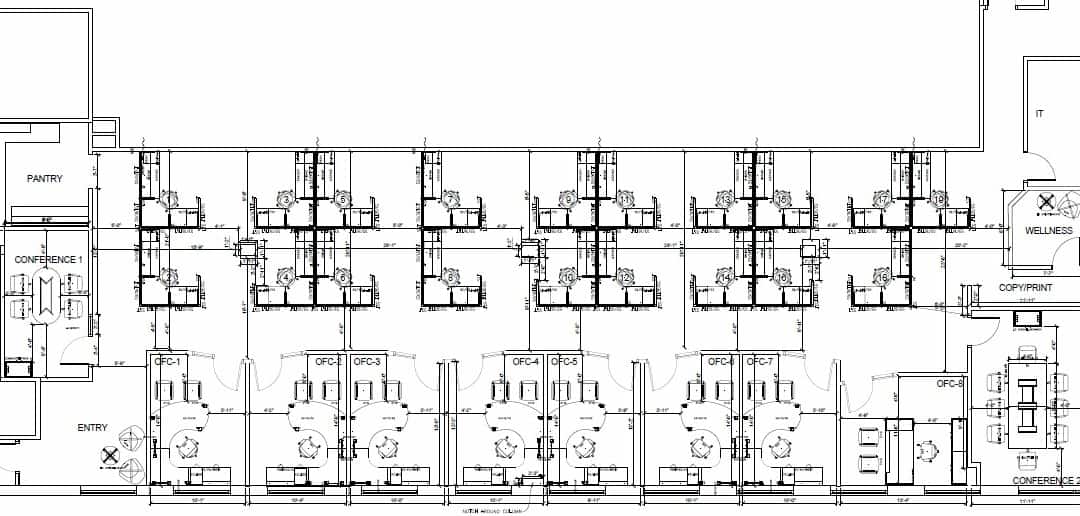Office Cubicle Layout and Design
In determining how to lay out cubicle areas within an office, employers must consider a multitude of factors. Key goals include: creating a conducive and welcoming work environment, balancing privacy with collaboration, and creating the flexibility to cope with the ebbs and flows of the new hybrid work model and lack of permanent desk space.
A number of years ago, cubicles declined in popularity as open-office designs became commonplace. Today, employees desire more privacy, creating a renewed demand for cubicles for the modern hybrid office.
Cubicle design within an office can vary significantly depending on the needs of the company and the preferences of the employees who will be using the cubicles. Employers and designers must consider the design of the individual cubicles as well as how the cubicles are laid out in the larger office.
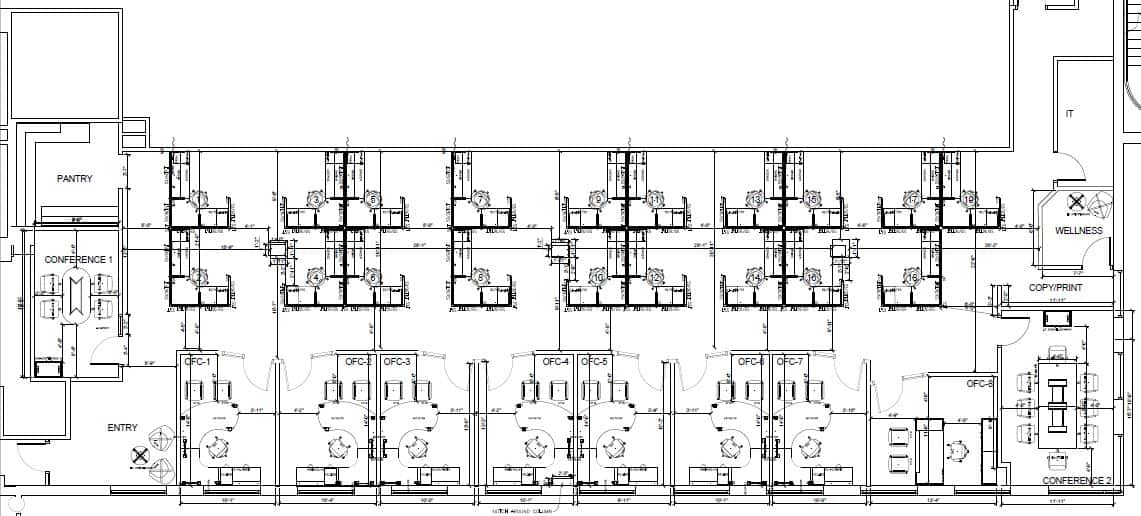
Office design of cubicles
Cubicle Design
An office cubicle is a small, partitioned workspace that is typically used by one employee at a time. The design of an office cubicle can vary depending on company needs and employee preferences. Listed below are common elements of cubicle design, followed by examples of popular cubicle layouts.
Elements of Cubicle Design:
Cubicle Size: Cubicles are typically small, enclosed workspaces that are designed to fit one person. The size of a cubicle can vary, but most are between 6 and 8 feet in length and width. Cubicle heights of 53” or 67” are the most common. Some offices choose a combination of cubicle heights.
Cubicle Walls: Cubicle walls are usually made of fabric, glass, laminate, or a combination of all three. They are designed to provide a barrier between employees and to minimize distractions.
Desk and Work Surface: Most cubicles include a desk or surface where employees can work. The size and shape of the desk can vary, but most are designed to provide enough space for a computer, phone, and other office supplies. Worksurfaces can be static (fixed) or height-adjustable.
Storage: Cubicles often include storage options such as shelves, cabinets, and drawers that can hold or contain office supplies, files, and personal belongings.
Modular Cubicles: Modular cubicles adapt to accommodate a changing number of in-office employees. They can be reorganized into a variety of layouts. When flexibility is needed, businesses should consider modular cubicles that offer the option of adjusting the office layout as business and workforce needs change.
For cubicle-design inspiration, view our gallery of more than 50 different designs on Pinterest.
Shop Cubicles
Cubicle Layouts & Office Design
How cubicles are arranged and laid out has the biggest impact on the overall design of an office. Designing an office with cubicles requires careful planning and consideration of the needs of employees, the available space, and the desired functionality of the workspace. Let’s explore some of the steps that are recommended in the cubicle-layout and office-design process.
Following these steps, you can design an office with cubicles that meets the needs of your employees, promotes productivity, and enhances the overall functionality and aesthetic of the space.
1. Before you begin designing your office space, it is important to identify your goals and objectives. Consider factors such as the company culture, the number and needs of your employees, and the overall functionality of the space. A big consideration is the hybrid remote schedule that many offices now follow. How many employees will be in the office at one time? How many will need a cubicle?
2. Analyze the available space to determine how many cubicles you can fit comfortably in the area. Consider the size and layout of the room, as well as any structural or design constraints. Compare how much space you have against the number of employees that need cubicles or other workstations.
3. Once you have determined the number of workstations needed and compared that total against the available space, create a floor plan that includes the desired location and layout of the cubicles. Be sure to consider traffic flow, accessibility, and the overall aesthetic of the space.
4. How your cubicles will connect to electricity and data must also be taken into account.
5. Choose the cubicle design and materials that meet your needs and preferences. Consider affordability, durability, flexibility, and the ability to customize the cubicles to meet the specific needs of your employees. Do you want modular cubicles in case you need to make changes down the road?
6. Once you have selected the cubicle design, determine the furniture and accessories that are needed to complete the workspace. These elements may include desks, chairs, storage units, and lighting.
7. Plan for technology needs, such as power outlets, cable management, and wireless access points. Ensure that your employees have the necessary tools and resources to be productive in their cubicles.
8. Cubicle design is only one element of the broader category of office design. With a solid understanding of what you need from cubicles, integrate that knowledge with other known office needs as you finalize the design of your office.
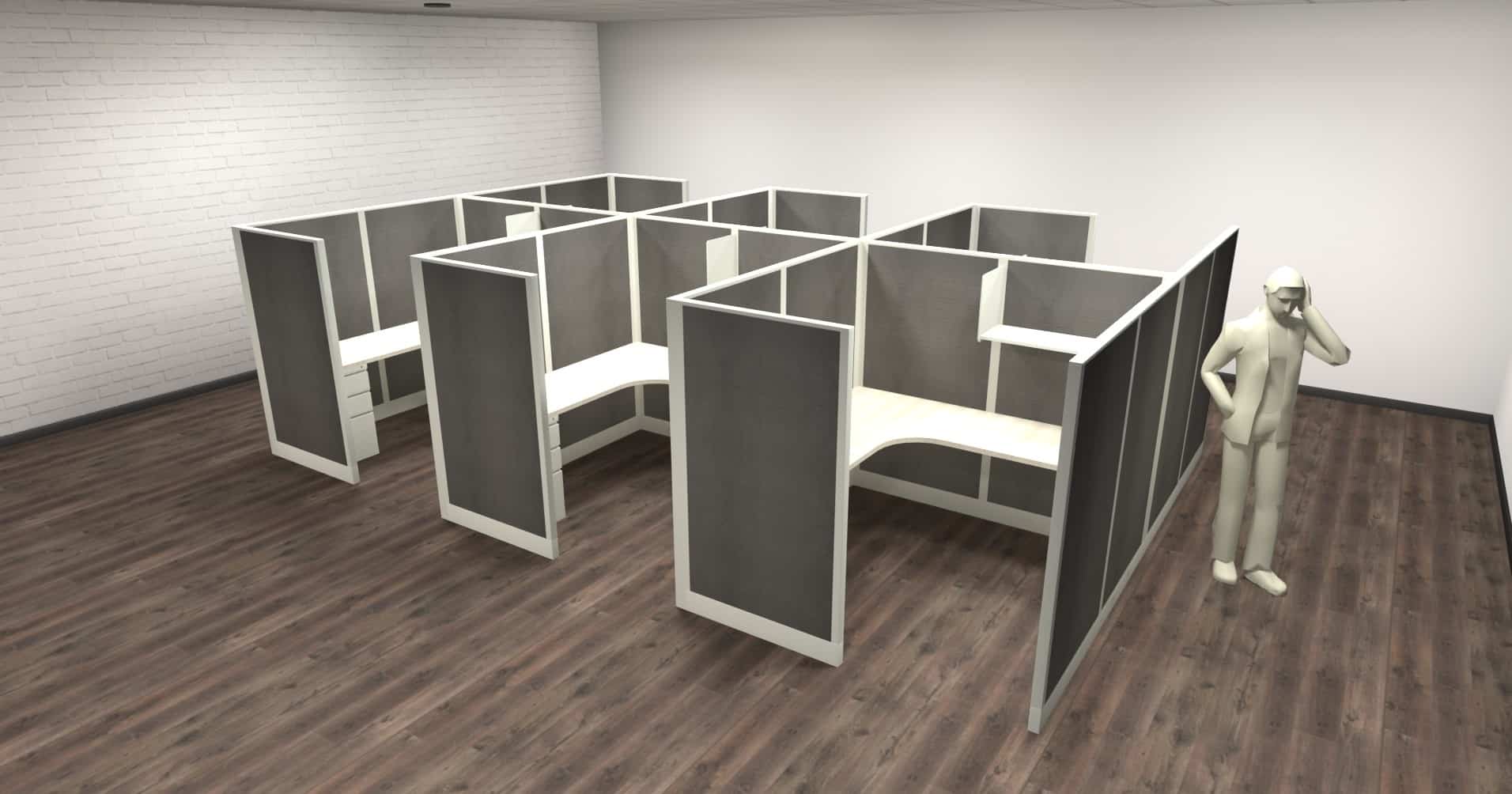
6-person cubicle
Popular Cubicle Layouts
Bullpen
Bullpen cubicles are often arranged in a large open space, typically in a grid-like pattern. They allow team members to communicate and collaborate easily, making them ideal for team-oriented work. They can also be more cost-effective and space-efficient than traditional cubicles or individual offices. However, bullpen cubicles may not be suitable for work that requires a high level of privacy, as they can be noisy and distracting.
Here are some common use-cases for offices with bullpen cubicles:
- Bullpen cubicles are ideal for teams that need to collaborate on projects. Placing team members in close proximity makes it easier for them to share ideas and communicate effectively.
- Bullpen cubicles can be more efficient than traditional closed-off cubicles because they use space more effectively. They are also easier to reconfigure as the needs of the team change over time.
- Team members can communicate with each other without barriers in an arrangement of bullpen cubicles. This set-up allows for more frequent and informal communication, which can facilitate problem-solving and build team cohesion.
- Managers often like the sales teams in a bullpen layout because, in addition to communication and collaboration, the layout fosters competition among teammates, which is said to help motivate workers.
- When managers are training and managing large teams, the bullpen makes it easier oversee and assist employees who may need help from an experienced team member.
- Bullpen cubicles can be a more cost-effective option than individual offices or traditional cubicles because they share space.

Sample bullpen style cubicle
The office-design rendering below shows the narrow layout of a small office space where maximizing the square footage was imperative. The design lent itself well to the more compact bullpen cubicle design. To fit the requested 12 workstations, JCI recommended 3 sets of 4 Person Sit/Stand Bullpen units (shown in the image above). This option fit the space well. Utilizing the corner-facing workstation orientation of this bullpen design provided a feeling of isolation that minimized distractions for employees facing their computers. With this design, employees can turn their chairs toward the middle to enable collaboration and teamwork as needed.
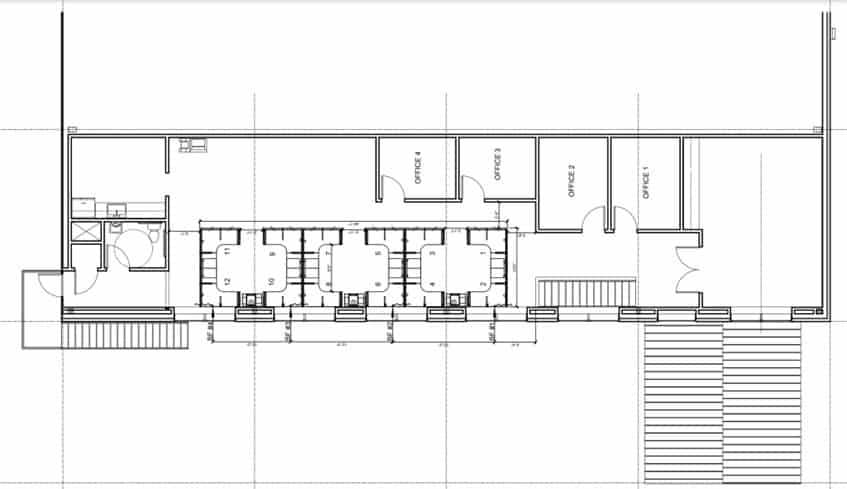
Office design of bullpen cubicles
Cluster
Cluster cubicles are grouped together in small bunches, usually with three or four workstations per cluster. They allow team members to work together closely, facilitating communication and collaboration. Cluster cubicles are also great for supervisors who need to monitor team members’ work closely. However, like bullpen cubicles, cluster cubicles may not provide enough privacy for work that requires a high level of concentration or confidentiality. Clusters typically have workers facing into the middle toward each other—almost the opposite of the bullpen arrangement where workers typically face out with their backs in the middle of the space.
Here are some common use-cases for offices with cluster cubicles:
- Cluster cubicles are ideal for teams that work together on projects. When team members are situated in close proximity, it is easier for them to share ideas and collaborate effectively.
- Cluster cubicles help supervisors who must monitor team members’ work. When a group of team members works together closely, the supervisor can observe the work and provide guidance as needed.
- In cluster cubicles, team members can communicate with each other with ease and without any barriers. These cubicles allow for more frequent and informal communication, which can build team cohesion.
- Cluster cubicles can be adapted easily to different types of work. They can be used for individual work, collaborative work, and even for meetings or training sessions.
- Cluster cubicles use space more efficiently than traditional cubicles or individual offices. They permit more team members to work in the same space, while still providing each person privacy and personal workspace.
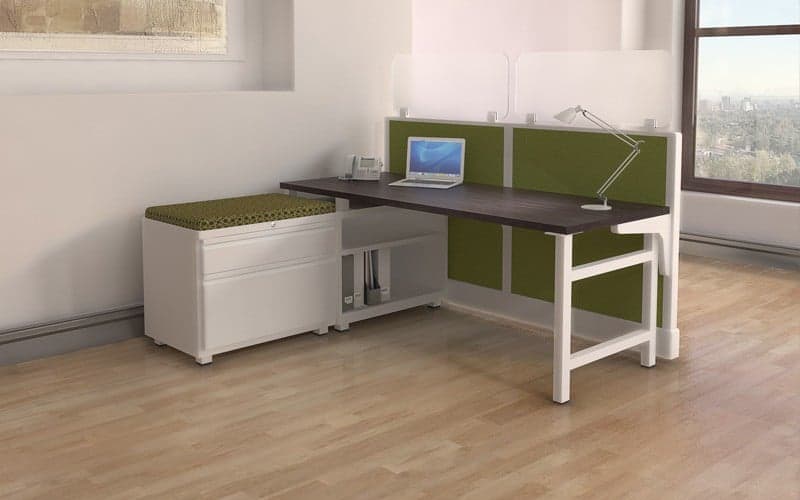
Semi-private cubicle style workstation
This client chose mostly private offices that lined the perimeter of the office space. In the middle of the room, they needed a solution to fit 5 more workstations, with an option for workstation #6. This layout is great for collaboration. The office design is shown in the rendering below. JCI considered using Semi-Private Cubicle Style Workstation (pictured above) or for this use-case. While the 4-person open workstation are a bit more economical per person, the semi-private cubicle style offers more privacy and helps reduce distractions.

Office design
Straight Run
Straight-run cubicles are arranged in a linear design, often along a wall or partition. This layout suits offices that have a long narrow run between walls, private interior offices, or other areas of the office that would be adjacent to the run of cubicles. Straight-run cubicles provide more privacy and sound isolation than other layouts, making them ideal for work that requires concentration or confidentiality.
An office design may opt for cubicles organized in a straight run, rather than other layouts such as bullpen or cluster cubicles, for several reasons:
- The overall layout of the office may lend itself to straight-run cubicles in order to maximize the number of workstations within the square footage. This may be particularly true when the office includes narrow corridors between walls.
- A layout with straight-run cubicles helps workers focus on their individual tasks by minimizing distractions and interruptions from coworkers.
- Straight-run cubicles have been a popular cubicle layout for many years; some offices may prefer a more traditional design over newer, open layouts like bullpen or cluster cubicles.

Straight run of cubicles
The rendering below demonstrates how a straight-run layout is ideal for the office’s interior structure, maximizing workstations within the square footage. With two-person offices lining the exterior wall and the main conference room on the other side, this straight-run cubicle layout is perfect for the narrow corridor created by the internal walls. Where the office opens up by the entrance, there was room to add a second (shorter) run of cubicles in that space.
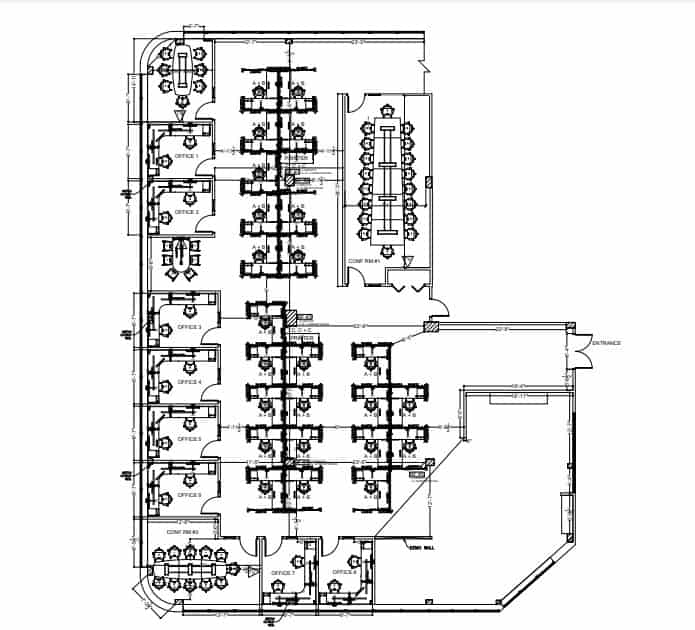
Office design of a straight run of cubicles
Cubicle Design in the Hybrid Office
The hybrid office paradigm combines remote work with on-site work, allowing employees to work both in the office and from home. This model is now common for many businesses responding to the challenges of the COVID-19 pandemic. In a hybrid office, cubicles can be used in a variety of ways to create a functional and flexible workspace.
Here are some examples of how a hybrid office may use cubicles:
Collaborative Spaces: Hybrid offices often include collaborative spaces where employees can work together on projects. Cubicles can create semi-private areas within these collaborative spaces where small groups of employees can work together without disturbing others.
Private Workspaces: While many employees appreciate the flexibility of remote work, there are times when they need to be in the office for project work or to meet with colleagues. Cubicles can create private workspaces where employees can focus on their work and minimize distractions.
Hot-Desking: In a hybrid office, employees may not have assigned desks or workstations. Instead, they may use a hot-desking system where they choose a workspace that meets their needs for the day. Cubicles can create flexible workspaces that can be reconfigured easily to meet the needs of different employees.
Videoconferencing: With more employees working remotely, videoconferencing has become essential within many workplaces. Cubicles can be designed to include videoconferencing equipment and screens, allowing remote employees to participate in meetings and collaborate with colleagues in the office.
Health and Safety: The COVID-19 pandemic has highlighted the importance of creating a safe and healthy workplace. Cubicles can create physical barriers between employees, reducing the risk of transmission of airborne diseases

